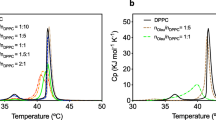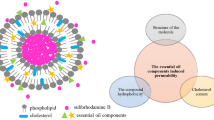Abstract
Liposomes made from a natural marine lipid extract and containing a high polyunsaturated n−3 fatty lipid ratio were envisaged as oral route vectors and a potential α-tocopherol supplement. The behavior of vesicles obtained by simple filtration and of giant vesicles prepared by electroformation was investigated in gastrointestinal-like conditions. The influence of α-tocopherol incorporation into liposomes was studied on both physical and chemical membrane stability. Propanal, as an oxidation product of n−3 polyunsaturated fatty acids, was quantified by static headspace gas chromatography when α-tocopherol incorporation into liposome ratios ranged from 0.01 to 12 mol%. Best oxidative stability was obtained for liposomes that contained 5 mol% α-tocopherol. Compared to the other formulas, propanal formation was reduced, and time of the oxidation induction phase was longer. Moreover, α-tocopherol induced both liposome structural modifications, evidenced by turbidity, and phospholipid chemical hydrolysis, quantified as the amount of lysophospholipids. This physicochemical liposome instability was even more pronounced in acid storage conditions, i.e., α-tocopherol incorporation into liposome membranes accelerated the structural rearrangements and increased the rate of phospholipid hydrolysis. In particular, giant vesicles incubated at pH 1.5 underwent complex irreversible shape transformations including invaginations. In parallel, the absorption rate of α-tocopherol was measured in lymph-cannulated rats when α-tocopherol was administrated, as liposome suspension or added to sardine oil, through a gastrostomy tube. α-Tocopherol recovery in lymph was increased by almost threefold, following liposome administration. This may be related to phospholipids that should favor α-tocopherol solubilization and to liposome instability in the case of a high amount of α-tocopherol in the membranes. A need to correlate results obtained from in vitro liposome behavior with in vivo lipid absorption was demonstrated by this study.
Similar content being viewed by others
Abbreviations
- DHA:
-
docosahexaenoic acid
- EPA:
-
eicosapentaenoic acid
- GC:
-
gas chromatography
- HPLC:
-
high-performance liquid chromatography
- LPC:
-
lysophosphatidylcholine
- LPE:
-
lysophosphatidylethanolamine
- OD:
-
optical density
- PC:
-
phosphatidylcholine
- PE:
-
phosphatidylethanolamine
- PUFA:
-
polyunsaturated fatty acid
References
Jenski, L., Scherer, J., Caldwell, L.D., Ney, V., and Stillwell, W. (1998) The Triggering Signal Dictates the Effect of Docosahexaenoic Acid on Lymphocyte Function in Vitro, Lipids 33, 869–878.
Stanley, J. (1999) The Role of Fish Oil in Disease Management. Rheumatoid Arthritis, Lipid Technol., 61–64.
Kelley, D.S., Taylor, P.C., Nelson, G.J., Schmidt, P.C., Ferreti, A., Erickson, K.L., Yu, R., Chandra, R., and Mackey, B.E. (1999) Docosahexaenoic Acid Ingestion Inhibits Natural Killer Cell Activity and Production of Inflammatory Mediators in Young Healthy Men, Lipids 34, 317–324.
Kremer, J.M. (2000) n−3 Fatty Acid Supplements in Rheumatoid Arthritis, Am. J. Clin. Nutr. 71, 349S-351S.
Roche, H.M., and Gibney, M.J. (2000) Effect of Long-Chain n−3 Polyunsaturated Fatty Acids on Fasting and Postprandial Triacylglycerol Metabolism, Am. J. Clin. Nutr. 71, 232S-237S.
Harris, W. (1989) Fish Oils and Plasma Lipid and Lipoprotein Metabolism in Humans: A Critical Review, J. Lipid Res. 30, 785–807.
Nestel, P.J. (2000) Fish Oil and Cardiovascular Disease: Lipids and Arterial Function, Am. J. Clin. Nutr. 71, 228S-231S.
Vognild, E., Elvevoll, E.O., Brox, J., Olsen, R., Barstad, H., Aursand, M., and Osterud, B. (1998) Effects of Dietary Marine Oils and Olive Oils on Fatty Acid Composition, Platelet Membrane Fluidity, Platelet Responses, and Serum Lipids in Healthy Humans, Lipids 33, 427–436.
Ikeda, I., Hiroko, Y., Tomooka, M., Yosef, A., Imaizumi, K., Tsuji, H., and Seto, A. (1998) Effects of Long-Term Feeding of Marine Oils with Different Positional Distribution of Eicosapentaenoic and Docosahexaenoic Acids on Lipid Metabolism, Eicosanoid Production, and Platelet Aggregation in Hypercholesterolemic Rats, Lipids 33, 897–904.
De Deckere, E.A.M., Korver, O., Verschuren, P.M., and Katan, M.B. (1998) Health Aspects of Fish and n−3 Polyunsaturated Fatty Acids from Plant and Marine Origin, Eur. J. Clin. Nutr. 52, 749–753.
Connor, W. (2000) Importance of n−3 Fatty Acids in Health and Disease, Am. J. Clin. Nutr. 71, 171S-175S.
Nelson, G.J., Schmidt, P.C., Bartolini, G.L., Kelley, D.S., and Kyle, D. (1997) The Effect of Dietary Docosahexaenoic Acid on Plasma Lipoproteins and Tissue Fatty Acid Composition in Humans, Lipids 32, 1137–1146.
Frankel, E.N. (1984) Lipid Oxidation: Mechanisms, Products, and Biological Significance, J. Am. Oil Chem. Soc. 61, 1908–1917.
Kagan, V.E. (1988) Lipid Peroxidation in Biomembranes, p. 181, CRC Press, Boca Raton.
Halliwell, B. (1985) Oxidation of Low-Density Lipoproteins: Questions of Initiation, Propagation, and the Effect of Antioxidants, Am. J. Clin. Nutr. 61, 670–677.
Noguchi, N., and Niki, E. (1998) Dynamics of Vitamin E Action Against LDL Oxidation, Free Radicals Res. 28, 561–572.
Massey, F.B., and Pownall, H.J. (1998) Interaction of α-Tocopherol with Model Human High-Density Lipoproteins, Biophys. J. 75, 2923–2931.
Kamal-Eldin, A., and Appelqvist, L.A. (1996) The Chemistry and Antioxidant Properties of Tocopherols and Tocotrienols, Lipids 31, 671–701.
Bostick, R.M., Potter, J.D., McKenzie, D.R., Sellers, T.A., Kushi, L.H., Steinmetz, K.A., and Folsom, A.R. (1993) Reduced Risk of Colon Cancer with High Intake of Vitamin E: The Iowa Women’s Health Study, Cancer Res. 53, 4230–4237.
Le Gardeur, B.Y., Lopez-S, A., and Johnson, W.D.A. (1990) Case-Control Study of Serum Vitamins A, E, and C in Lung Cancers Patients, Nutr. Cancer 14, 133–140.
Chan, A.C. (1998) Vitamin E and Atherosclerosis, J. Nutr. 128, 1593–1596.
Pryor, W.A. (2000) Vitamin E and Heart Disease: Basic Science to Clinical Intervention Trials, Free Radicals Biol. Med. 28, 141–164.
Stanley, J. (1999) Vitamin E—Nutrient or Pharmaceutical, Lipid Technol., 36–39.
Kayden, H.J., and Traber, M.G. (1993) Absorption, Lipoprotein Transport, and Regulation of Plasma Concentrations of Vitamin E in Humans, J. Lipid Res. 34, 343–358.
Senior, J.H., Gregoriadis, G. Muller, D.P.R., Pathak, Y.V., and McIntyres, N. (1988) Liposomes Facilitate Uptake of Lipid-Soluble Vitamins After Oral Delivery to Normal and Bile-Duct Obstructed Rats, Biochem. Soc. Trans. 17, 121–122.
Kelleher, J., and Losowsky, M.S. (1970) The Absorption of α-Tocopherol in Man, Br. J. Nutr. 24, 1033–1047.
Scott, M.L. (1978) Vitamin E, in The Fat-Soluble Vitamins. Handbok of Lipid Research (DeLuca, H.L., ed.), pp. 133–210, Plenum Press, New York.
Bontempo, V., Baldi, A., Cheli, F., Fantuz, F., Politis, I., Carli, S., and Dell’Orto, V. (2000) Kinetic Behavior of Three Preparations of α-Tocopherol After Oral Administration to Postpubertal Heifers, Am. J. Vet. Res. 61, 589–593.
Julianto, T., Yuen, K.H., and Noor, A.M. (2000) Improved Bioavailability of Vitamin E with a Self Emulsifying Formulation, Int. J. Pharm. 200, 53–57.
Borel, P., Pasquier, B., Armand, M., Tyssandier, V., Grolier, P., Alexandre-Gouabau, M.C., André, M., Senft, M., Peyrot, J., Jaussan, V., Lairon, D., and Azais-Braesco, V. (2001) Processing of Vitamin A and E in the Human Gastrointestinal Tract, Am. J. Physiol. Gastrointest. Liver Physiol. 280, G95-G103.
Bateman, N.E., and Ucellini, D.A. (1984) Effect of Formulation on the Bioavailability of Retinol, d-α-Tocopherol and Riboflavine, J. Pharm. Pharmacol. 36, 461–464.
Baudimant, G., Maurice, M., Landrein, A., Durand, G., and Durand, P. (1996) Purification of Phosphatidylcholine with High Content of DHA from Squid Illex argentinus by Countercurrent Chromatography, J. Liq. Chrom. Rel. Technol. 19, 1793–1804.
Nacka, F., Cansell, M., and Entressangles, B. (2001) In Vitro Behavior of Marine Lipid-Based Liposomes. Influence of pH, Temperature, Bile Salts, and Phospholipase A2, Lipids 36, 35–42.
Nacka, F., Cansell, M., Gouygou, J.P., Gerbeaud, C., Méléard, P., and Entressangles, B. (2001) Physical and Chemical Stability of Marine Lipid-Based Liposomes Under Acid Conditions, Colloids Surf. B: Biointerfaces 20, 257–266.
Folch, J., Lees, M., and Sloane-Stanley, G.H. (1957) A Simple Method for Isolation and Purification of Total Lipides from Animal Tissues, J. Biol. Chem. 226, 497–509.
Ames, B.N. (1966) Assay of Inorganic Phosphate, Total Phosphate, and Phosphatase, Methods Enzymol. 18, 115–118.
Bollman, J.L., Cain, J.C., and Grindlay, J.H. (1948) Techniques for the Collection of Lymph from the Liver, Small Intestine, or Thoracic Duct of Rat, J. Lab. Clin. Med. 33, 1349–1352.
Combe, N., Constantin, M.J., and Entressangles, B. (1981) Lymphatic Absorption of Nonvolatile Oxidation Products of Heated Oils in the Rat, Lipids 16, 8–14.
Nara, E., Miyashita, K., Ota, T., and Nadachi, Y. (1998) The Oxidative Stabilities of Polyunsaturated Fatty Acids in Salmon Egg Phosphatidylcholine Liposomes, Fisheries Sci. 64, 282–286.
Saito, H., and Ishihara, K. (1997) Antioxidant Activity and Active Sites of Phospholipids as Antioxidants, J. Am. Oil Chem. Soc. 74, 1531–1536.
Bandarra, N.M., Campos, R.M., Batista, I., Nunes, M.L., and Empis, J.M. (1999) Antioxidant Synergy of α-Tocopherol and Phospholipids, J. Am. Oil Chem. Soc. 76, 905–913.
Nara, E., Miyashita, K., and Ota, T. (1997) Oxidative Stability of Liposomes Prepared from Soybean PC, Chicken Egg PC, and Salmon Egg PC, Biosci. Biotechnol. Biochem. 61, 1736–1738.
Finean, J.B. (1990) Interaction between Cholesterol and Phospholipid in Hydrated Bilayers, Chem. Phys. Lipids 54, 147–156.
Ohyashiki, T., Karino, T., and Matsui, K. (1993) Stimulation of Fe2+-Induced Lipid Peroxidation in Phosphatidylcholine Liposomes by Aluminium Ions at Physiological pH, Biochim. Biophys. Acta 1170, 182–188.
Grit, M., and Crommelin, D.J.A. (1993) Chemical Stability of Liposomes: Implications for Their Physical Stability, Chem. Phys. Lipids 64, 3–18.
Halks-Miller, M., Guo, L.S.S., and Hamilton, R.L. (1985) Tocopherol-Phospholipid Liposomes: Maximum Content and Stability to Serum Proteins, Lipids 20, 195–200.
Wassal, S.R., Yang, R.C., Wang, L., Phelps, T.M., Erhinger, W., and Stillwell, W. (1990) Magnetic Resonance Studies of the Structural Role of Vitamin E in Phospholipid Model Membranes, Bull. Magnet. Res. 12, 60–64.
Berndl, K., Käs, J., Lipowsky, R., Sackmann, E., and Seifert, U. (1990) Shape Transformations of Giant Vesicles: Extreme Sensitivity to Bilayer Asymmetry, Europhys. Lett. 13, 659–664.
Farge, E., and Devaux, P.F. (1992) Shape Changes of Giant Liposomes Induced by an Asymmetric Transmembrane Distribution of Phospholipids, Biophys. J. 61, 347–357.
Bieri, J.G., Corash, L., and Hubbard, V.S. (1983) Medical Uses of Vitamin E, New Engl. J. Med. 308, 1063–1071.
Ikeda, I., Imasato, Y., Sasaki, E., and Sugano, M. (1996) Lymphatic Transport of Alpha-, Gamma-, and Delta-Tocotrienols and Alpha-Tocopherol in Rats, Int. J. Vitam. Nutr. Res. 66, 217–221.
Traber, M.G., Kayden, H.J., Green, J.B., and Green, M.H. (1986) Absorption of Water-Miscible Forms of Vitamin E in a Patient with Cholestasis and in Rats, Am. J. Clin. Nutr. 44, 914–923.
Porsgaard, T., and Høy, C.E. (2000) Absorption by Rats of Tocopherols Present in Edible Vegetable Oils, Lipids 35, 1073–1078.
Tijburg, L.B., Haddeman, E., Kivits, G.A., Weststrate, J.A., and Brink, E.J. (1997) Dietary Linoleic Acid at High and Reduced Dietary Fat Level Decreases the Faecal Excretion of Vitamin E in Young Rats, Br. J. Nutr. 77, 327–336.
Muralidhara, K.S., and Hollander, D. (1997) Intestinal Absorption of Alpha-Tocopherol in the Unanesthetized Rat. The Influence of Luminal Constituents on the Absorptive Process, J. Lab. Clin. Med. 90, 85–91.
Koo, S.I., and Noh, S.K. (2001) Phosphatidylcholine Inhibits and Lysophosphatidylcholine Enhances the Lymphatic Absorption of Alpha-Tocopherol in the Adult Rats, J. Nutr. 131, 717–722.
Author information
Authors and Affiliations
Corresponding author
About this article
Cite this article
Nacka, F., Cansell, M., Méléard, P. et al. Incorporation of α-tocopherol in marine lipid-based liposomes: in vitro and in vivo studies. Lipids 36, 1313–1320 (2001). https://doi.org/10.1007/s11745-001-0846-x
Received:
Revised:
Accepted:
Issue Date:
DOI: https://doi.org/10.1007/s11745-001-0846-x




